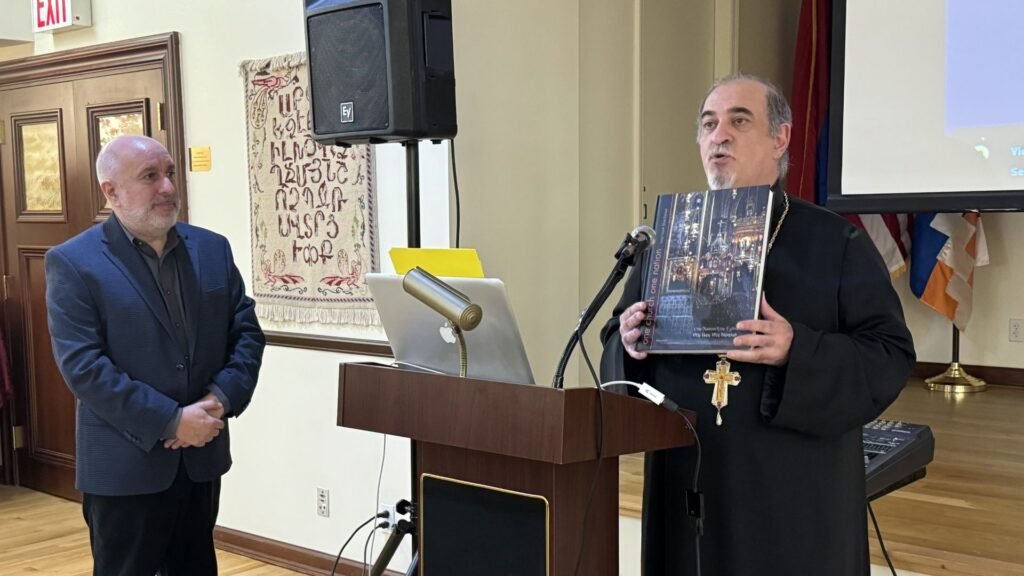
On Sunday, December 3, our very own organist Ara Dinkjian treated our congregation and guests to a lecture on “Early Recordings of Armenian Classics.” Rev. Fr. Mesrob Lakissian introduced the program, which was made possible by the Cathedral’s “Ghazarian Fund.” Following are parishioner Kevork Khrimian’s reflections on the occasion.
Armenian church hall lectures have been a mainstay of the Armenian community, probably for as long as there have been Armenian church halls. In 1973, when I was 13, three lectures on consecutive Sundays at St. Illuminator’s by the late Titans Nina Garsoïan, Vartan Gregorian and Richard Hovannisian had a profound and lasting effect on my understanding of all things Armenian and set the standard for me not just for church hall lectures, but all lectures. Dinkjian’s lecture on Sunday, which was enriching, engaging and entertaining, evoked that standard.
Dinkjian’s presentation consisted mainly of snippets of music from his vast personal collection of early Armenian recordings, along with his commentary and historic references, which provided the necessary context for fully appreciating each gem. Dinkjian began with a recording of Gomidas Vartabed performing his own “Aror Yev Dadrak” recorded in 1908 in Alexandrapol (now Gyumri). The Vartabed’s haunting voice evoked two immediate but vastly different reactions. First, listening to Gomidas almost immediately after celebrating Soorp Badarak in the sanctuary just above the hall, offered new appreciation and color to the Soorp Badarak, which we sometimes miss. Second, the fact that the recording was made in what is now Gyumri underscored the historic significance of Gyumri relative to Yerevan and all urban centers of Eastern Armenia, prior to the establishment of the First Republic and subsequent Sovietization.

After several more examples from the “Old Country” recorded in the early part of the 20th century, Dinkjian turned to the New World and the genesis and development of the Armenian American sound. He devoted a considerable amount of attention to what Armenian immigrants brought from their native regions of the homeland, which interestingly consisted mostly of the westernmost provinces of Armenia, including Dikranagerd, Kharpert and Sepastia. Thankfully, technology enabled them to record and preserve their cultural inheritance and avail it to the generations that followed.
Almost immediately after arriving in the United States, individuals with varying levels of talent and expertise in music, but healthy levels of entrepreneurship, established small recording companies and began recording the songs and dance music of their native communities. Dinkjian was quick to point out the regional nature of the unique and distinct music they brought with them. Music is often influenced by neighboring cultures. This amplified the differences between cultural elements of one region of the Armenian homeland from another. The direct distance between Malatya and Shushi is close to 500 miles, a long distance in a mountainous land. This is why the Armenian American sound, which evolved from its origin in the far west of the Armenian homeland, can sound so different from what we hear in the modern Republic of Armenia. Yet, as I took away from Dinkjian’s lecture, these differences highlight our cultural wealth through its diversity, and they are not the product of assimilation and degeneration, as some may suggest.

The efforts that these small recording companies made to preserve and grow their musical inheritance under intense pressure to assimilate, which we no longer experience, was also striking. The companies were often named after their founders, who were typically born in western Armenia in the late 19th century and died in the U.S. in the middle of the 20th century. They seemed proud to produce and sell their products for a dollar a record, and they probably made some money along the way in this “blessed country,” as Dinkjian put it.
Finally, it was a joy to watch our more senior members of the community gleefully sing along with the songs of their youth. They appeared transformed—the word that best describes the overall experience.



Be the first to comment